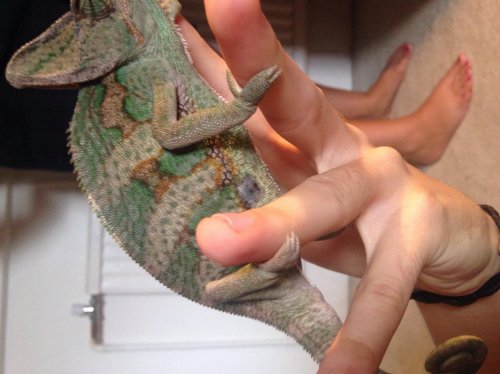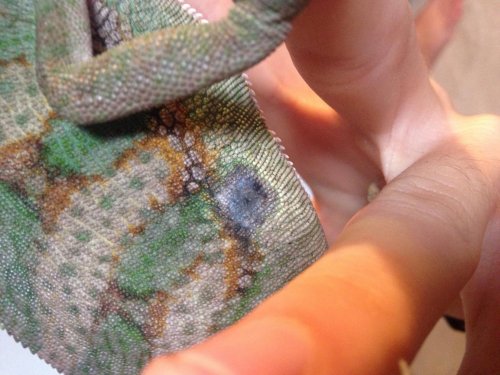Hi, I know there are a couple of similar threads to this but I wanted to ask for any ideas/suggestions regarding my Chameleon!
Chameleon Info:
Your Chameleon - Veiled, Male, 9 months old, had him since 3 months old.
Handling - Most days in a week
Feeding - Large brown crickets, gut loaded with veg scraps eg broccoli, lettuce. He has about 4-6 fiver or 6 days a week. Occasionally give him morio worms. Always dust them with calcium+ D3 wife a week or so.
Supplements - 'T-Rex' Calcium no phosphorus with D3 '2.0' for insect eating Lizards, Turtles and Snakes.
Watering - Plastic tub suspended above the cage, drips every couple of seconds into a big plastic leaf and then falls into a collection tub at the bottom of the cage. I fill it up about 3 times a week and it lasts a whole day dripping. I must every day. I have occasionally seen him licking a the big leaf.
Fecal Description - Never tested for any parasites. His colours are normal as far as I know, the same as they have always been. Droppings again are always the same. Mostly brown, same consistencies as a guinea pig, mouse etc! Small chunk of white with it too.
History - nope!
Cage Info:
Cage Type - Full screen 'repti breeze' 40x40x76cm cage.
Lighting - Exo terra UV bulb in exo terra lamp shade on top of the cage. Incandescent bulb from the side towards the top to create a basking zone, with a branch nearby. Both on a timer for 12 hours a day.
Temperature - Basking branch is 32 degrees, under the UV bulb is 27 and in the other areas of the cage it is about 24. Down the bottom is lower 20's. Also have a heat mat behind the cage up the top that comes on at night to keep the top part warmer, at about 24 degrees.
Humidity - normally around 35% when I have just misted it goes up to about 70 temporarily.
Plants - A very small Palm looking plant at the bottom. House pant style.
Placement - cage is on a unit in my bedroom, which has the door shut all day with no one in there. It is in the middle of the room but in line with a single window. I have a tall plant next to the cage which blocks direct sunlight but the some light does get through to the cage.
Location - Kent, UK.
Current Problem - he has a dark grey/blue ish patch on his side, where his knee reaches when he bends it up. It has been there for about 3-4 weeks, when he sheds his skin it seems to get stuck around the area and that patch never seems to shed the skin. I have tried keeping it clean with some luke warm water trickling g over it, and the same with some weak salt water. Within the last week he has started to eat less than normal. He had 2 worms yesterday, nothing today and the only other time he has eaten was a couple of worms and crickets before the weekend. It doesn't seem sore, when I touch it he doesn't hiss (he is more than happy to hiss when he wants to, getting him out of the cage is tricky!) it hasnt got any worse or better since it first developed. Not set looking in any way. No blood etc.
Pictures are helpful
Chameleon Info:
Your Chameleon - Veiled, Male, 9 months old, had him since 3 months old.
Handling - Most days in a week
Feeding - Large brown crickets, gut loaded with veg scraps eg broccoli, lettuce. He has about 4-6 fiver or 6 days a week. Occasionally give him morio worms. Always dust them with calcium+ D3 wife a week or so.
Supplements - 'T-Rex' Calcium no phosphorus with D3 '2.0' for insect eating Lizards, Turtles and Snakes.
Watering - Plastic tub suspended above the cage, drips every couple of seconds into a big plastic leaf and then falls into a collection tub at the bottom of the cage. I fill it up about 3 times a week and it lasts a whole day dripping. I must every day. I have occasionally seen him licking a the big leaf.
Fecal Description - Never tested for any parasites. His colours are normal as far as I know, the same as they have always been. Droppings again are always the same. Mostly brown, same consistencies as a guinea pig, mouse etc! Small chunk of white with it too.
History - nope!
Cage Info:
Cage Type - Full screen 'repti breeze' 40x40x76cm cage.
Lighting - Exo terra UV bulb in exo terra lamp shade on top of the cage. Incandescent bulb from the side towards the top to create a basking zone, with a branch nearby. Both on a timer for 12 hours a day.
Temperature - Basking branch is 32 degrees, under the UV bulb is 27 and in the other areas of the cage it is about 24. Down the bottom is lower 20's. Also have a heat mat behind the cage up the top that comes on at night to keep the top part warmer, at about 24 degrees.
Humidity - normally around 35% when I have just misted it goes up to about 70 temporarily.
Plants - A very small Palm looking plant at the bottom. House pant style.
Placement - cage is on a unit in my bedroom, which has the door shut all day with no one in there. It is in the middle of the room but in line with a single window. I have a tall plant next to the cage which blocks direct sunlight but the some light does get through to the cage.
Location - Kent, UK.
Current Problem - he has a dark grey/blue ish patch on his side, where his knee reaches when he bends it up. It has been there for about 3-4 weeks, when he sheds his skin it seems to get stuck around the area and that patch never seems to shed the skin. I have tried keeping it clean with some luke warm water trickling g over it, and the same with some weak salt water. Within the last week he has started to eat less than normal. He had 2 worms yesterday, nothing today and the only other time he has eaten was a couple of worms and crickets before the weekend. It doesn't seem sore, when I touch it he doesn't hiss (he is more than happy to hiss when he wants to, getting him out of the cage is tricky!) it hasnt got any worse or better since it first developed. Not set looking in any way. No blood etc.
Pictures are helpful




